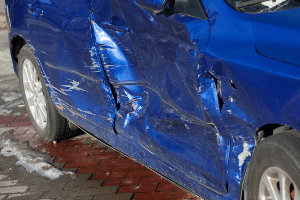 A T-bone collision is one where the side of a vehicle is impacted by the front of another. These collisions are sometimes called side-impact or broadside accidents. Determining liability for these types of crashes may require looking at several factors, including who had the right of way. Depending on how the crash occurred, establishing fault may be simple or complex.
A T-bone collision is one where the side of a vehicle is impacted by the front of another. These collisions are sometimes called side-impact or broadside accidents. Determining liability for these types of crashes may require looking at several factors, including who had the right of way. Depending on how the crash occurred, establishing fault may be simple or complex.
Let our Fort Worth-area car crash lawyers review your claim to determine how we may be able to help you secure compensation for your damages. There are no upfront fees while we work on your case and the initial consultation is free.
Why Do T-Bone Accidents Occur?
Generally, a T-bone collision occurs because one driver violates the right of way of another. These are some of the more common scenarios when T-bone collisions are more likely to occur:
- At an intersection – These types of accidents are most prevalent at intersections because at least one lane of vehicles has the right of way while the others do not. T-bone collisions often happen when one driver runs a red light or stop sign when another lane of traffic has a green light.
- Losing control of a vehicle – If someone is driving in a reckless manner and loses control of his or her vehicle, that person could accidentally cross into oncoming traffic where a T-bone collision could occur.
- In a parking lot – A vehicle pulling out of a parking spot could T-bone another if the driver did not check for passing traffic or if the passing traffic did not stop when the vehicle pulling out of a spot was already halfway out.
Aside from violating the rules of the road or driving recklessly, a driver could cause a T-bone accident if he or she is under the influence of drugs or alcohol or is distracted while driving.
Factors That Help to Determine Fault for a T-Bone Crash
As violating another driver’s right of way is usually a strong implication of fault, victims’ attorneys often need to establish that another driver violated their right of way.
For example, the driver who negligently crosses an intersection and causes a T-bone collision could be found to be responsible for the crash if the other vehicle had the right-of-way. On the other hand, if the vehicle making the turn in the intersection had a green light or some other indicator establishing that he or she had the right of way, the driver of the oncoming vehicle could be the responsible party.
Ultimately, fault is based on which driver acted negligently, and there are many T-bone accidents where both parties could be partially at fault.
Every case is different, and reviewing the facts is important to help determine who may be liable. It would be in your best interest to speak to an attorney right away if you were injured in a T-bone collision.
What Evidence Can Be Used to Prove Fault in a T-Bone Collision?
If you believe your right of way was violated in a T-bone collision, you can file a claim for compensation with that driver’s liability insurance. However, to recover compensation you must prove that other driver’s negligent actions directly resulted in your injuries.
Our attorneys are prepared to help you gather the evidence you need to build a strong case. Some of the evidence that may help prove fault in a T-bone collision includes:
- Police report
- Witness statements
- Photos/videos from the scene and damage to the vehicles
- Road signs in the area
When proving which driver had the right of way is more difficult, an attorney may turn to an expert witness who could reconstruct the accident to try to determine which driver acted negligently.
Injuries That Often Result From T-Bone Collisions
T-bone car accident injuries can be very serious, as the side of a vehicle is not usually reinforced the way the front and the back is.
If you are T-boned at an intersection by a driver who ran a red light or stop sign, your body is likely to jerk in a sideways motion in reaction to the impact. This could cause a serious head, neck or back injury. In addition to that jerking of your body, your head could slam into something solid inside your vehicle, like the door frame, resulting in a concussion or something more serious.
Other common injuries include:
- Spinal cord damage
- Traumatic brain injuries
- Broken bones
- Internal organ injuries
- Soft-tissue injuries
- And more
Victims of these injuries will likely need extensive medical treatment that could be costly.
Need Help Filing a Claim in Texas? Call Us Today
If you were injured in a T-bone collision, let our knowledgeable attorneys help you file a claim and build a strong case for compensation on your behalf.
We offer a free consultation and we do not charge you anything up front. There are no fees unless we win. There is no risk to you.
No upfront fees. No risks. Call (817) 920-9000 today.
